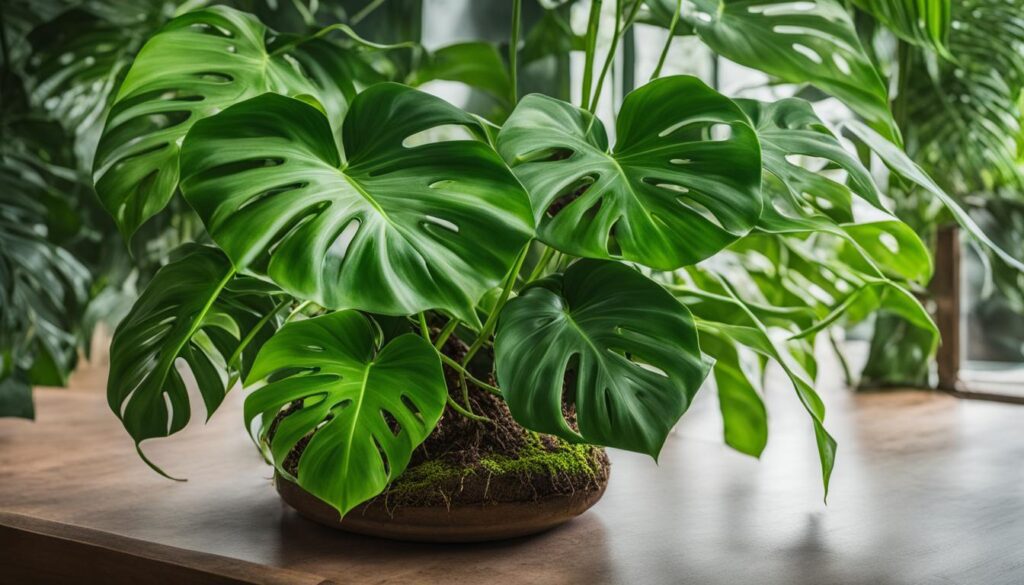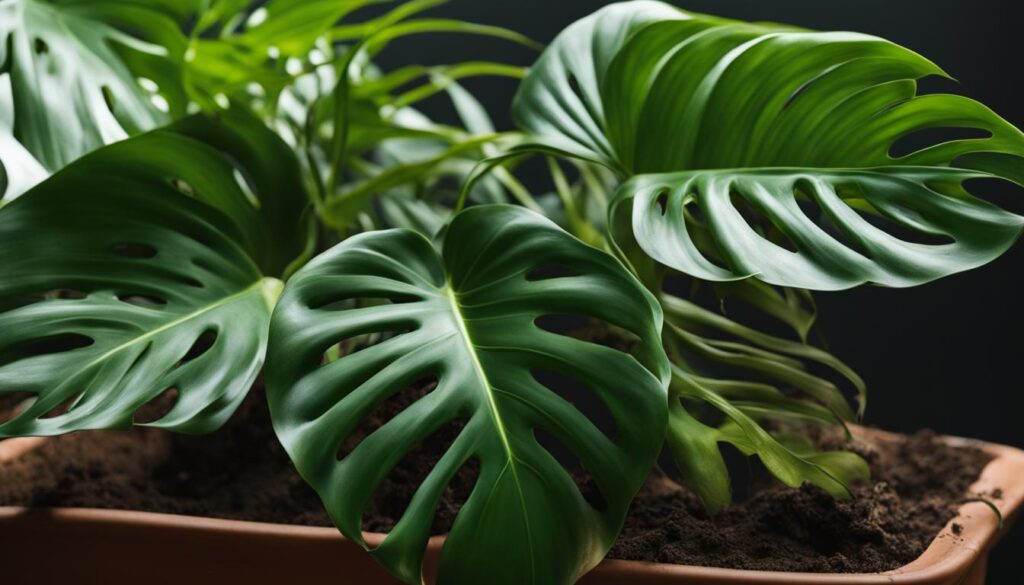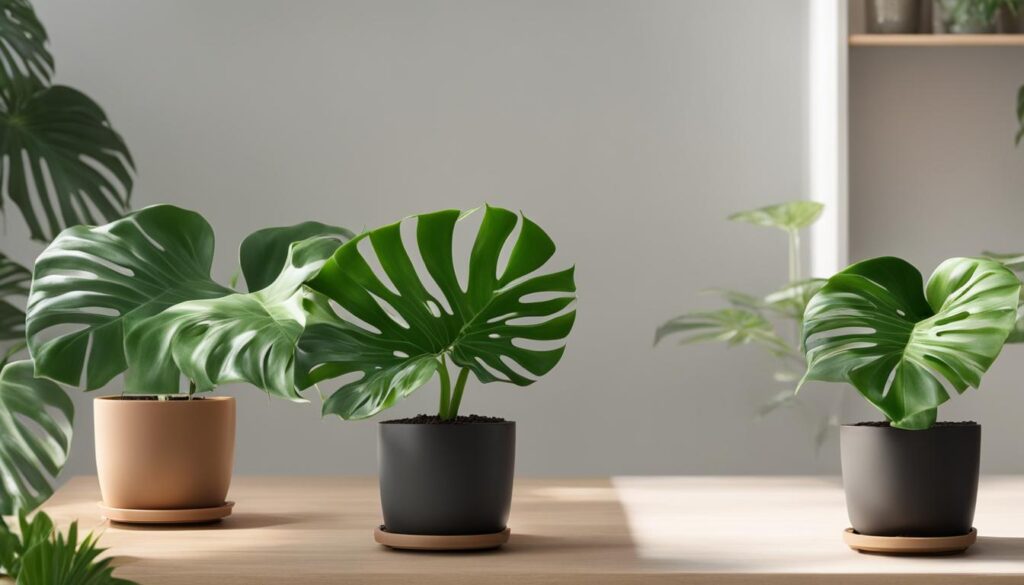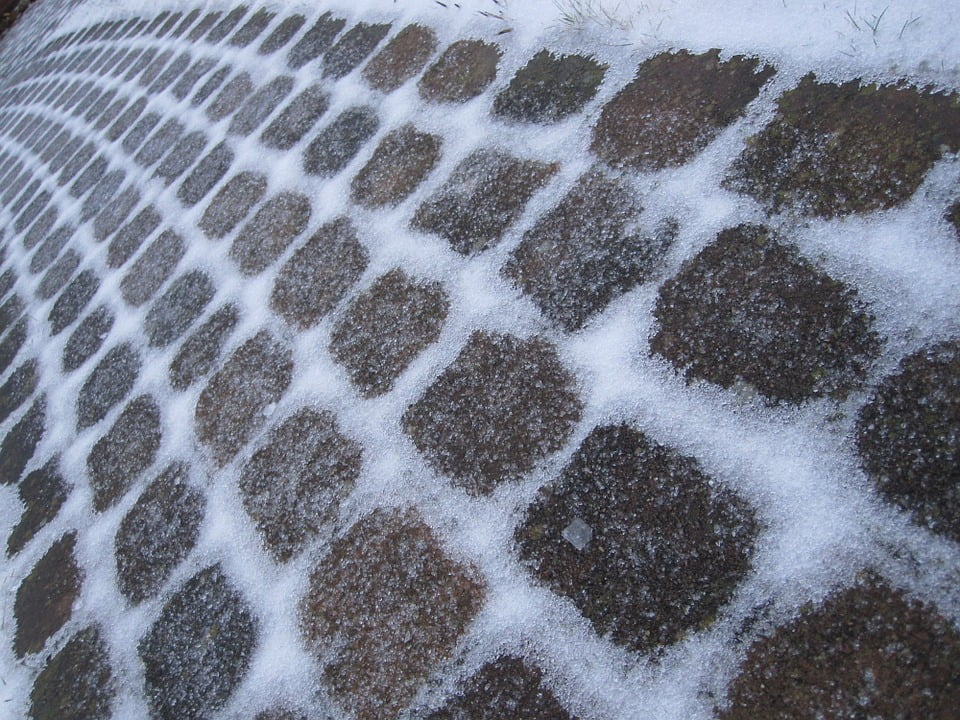Monstera Adansonii, commonly known as the Swiss Cheese Plant, is a popular choice for indoor foliage due to its striking appearance and easy-care nature. As your plant grows, it’s important to ensure that it has enough space to spread its roots and access the nutrients and moisture necessary for its continued well-being. In this article, we will explore the Monstera Adansonii’s preferences when it comes to being root bound and delve into the optimal pot size and care routine. Are you providing your plant with the right environment in which to thrive?
Key Takeaways
- Monstera Adansonii does not prefer to be root bound, as it may hinder its growth and health
- Repotting is a necessary part of Monstera Adansonii care, with young plants needing repotting annually and mature plants biennially
- Monitoring root growth and checking for signs of a root bound plant can help to maintain its health and vigor
- Choosing an appropriate pot and soil mix can significantly impact the overall well-being of your Monstera Adansonii
- Providing climbing support, such as trellises or moss poles, can encourage healthier growth patterns in your Swiss Cheese Plant
Unveiling the Monstera Adansonii’s Root Preferences
Originating from Central and South American rainforests, Monstera Adansonii boasts impressive growth habits, with its roots extending horizontally rather than digging deep into the soil. Given its tendency to climb trees, the plant relies heavily on healthy roots to anchor itself and absorb nutrients. Understanding the Monstera Adansonii’s root preferences is crucial for sustaining its growth and vitality as an indoor plant.
Monstera Adansonii prefers ample space for its roots to spread and thrive. As a guide, consider the natural habitat of these plants—climbing trees and extending roots across forest floors. To accommodate the growth habits of your Monstera Adansonii, proper indoor plant care should involve finding a balance between soil volume and root development, steering clear of cramped conditions and excessively spacious pots that could encourage moisture retention and root rot.
Choosing the right pot size and soil mixture for your Monstera encourages healthy growth and enables its roots to spread fully. When repotting, ensure the new pot is only slightly larger than the current one, with a diameter approximately two inches wider. Ideally, it should have drainage holes and be made of a breathable material like terracotta. An optimal pot size, along with high-quality, well-aerated potting mix, helps minimize the risks associated with root bound plants, such as stunted growth, nutrient deficiencies, and stress.
Root bound signs to watch for in your Monstera Adansonii include:
- Water draining too quickly through the pot, pooling at the bottom or immediately running out when watered.
- Roots visibly extending out of the pot’s drainage holes.
- Slow and stunted growth as well as the absence of new leaves.
- A plant that becomes top-heavy or unstable in its pot.
If you notice these signs, it may be time to repot your Monstera Adansonii and reevaluate its living conditions. Remember, providing an optimal environment for your plant’s roots will help ensure that your Monstera thrives, complementing your indoor space with its stunning, fenestrated leaves.
Identifying When Your Monstera Adansonii is Root Bound
Keeping an eye out for changes in plant behavior can help you identify critical moments to intervene and provide your Swiss Cheese Plant ample room for growth. Before setting out to repot your Monstera Adansonii, it is essential to recognize key root bound signs and perform a thorough root system examination to ensure proper plant care.
Signs Your Swiss Cheese Plant Needs More Space
There are a few Monstera Adansonii root bound signs to be aware of, including:
- Visible roots emerging from the planter’s drainage holes
- Water immediately runs out of the bottom when watered, indicating a disproportionate ratio of roots to soil
- Slow growth or stagnant Swiss Cheese Plant growth
- Decreased or ceased new leaf production
Any of these indicators may suggest that your Monstera Adansonii is overdue for repotting and needs more space for its roots to grow and maintain optimal health.
How to Safely Check if Your Plant is Root Bound
Perform a careful root inspection to assess whether your Swiss Cheese Plant requires repotting. To check if your Monstera Adansonii is root bound without damaging the plant, follow these simple steps:
- Tilt the pot and gently slide the plant out
- If the plant resists removal, use a butter knife to carefully run around the inside edge of the pot to help release the roots from the container
- Once removed, examine the root structure for tightly coiled roots at the bottom, which indicate a root bound condition
If you observe any of these signs during your Checking Monstera Adansonii roots process, you should plan to repot the plant accordingly.
Pot Bound vs. Healthy Root Systems
Understanding the difference between a pot bound Monstera Adansonii root system and a healthy one is vital to the plant’s overall wellbeing.
| Pot Bound Monstera | Healthy Monstera |
|---|---|
| Roots are tightly wound within themselves | Roots have room to grow and extend without tangling |
| Unable to access adequate nutrients and water due to overcrowded roots | Promotes better water absorption, nutrient uptake, and overall plant vigor |
| May cause stagnant growth or cessation of new leaf production | Encourages healthy and continuous Swiss Cheese Plant growth |
If your Monstera Adansonii displays root bound symptoms, it’s time to consider repotting Monstera to ensure that the plant can thrive and reach its full growth potential. A healthy root system promotes longevity and maintains the plant’s visual appeal and vigor.
The Impact of Being Root Bound on Monstera Adansonii
A root bound Monstera Adansonii faces significant stress, as its energy is diverted from growth to survival. Consequently, the restricted growth can potentially cause plant death if left unaddressed. In order to rejuvenate the plant and encourage the production of new foliage, it is essential to provide adequate root space after repotting.
When a Monstera Adansonii becomes root bound, a series of negative outcomes arise. Some of the key issues that impact the plant’s health include:
- Growth restriction: As the plant’s root system becomes more constricted, its growth will be hindered, affecting the overall size and aesthetic of the plant.
- Nutrient deficiency: Hindered root growth can result in poor nutrient absorption, leading to weak foliage and reduced vitality.
- Water management issues: A root bound plant struggles to take up enough water, causing stress that further exacerbates other conditions.
- Potential for root rot: When roots are compacted, the plant’s ability to properly drain excess water is impaired, introducing the risk of root rot and other root diseases.
To promote the long-term health of your Monstera Adansonii, it is crucial to monitor the plant for signs of being root bound. Observing the following indicators would help detect the onset of a root bound condition:
- Visible roots emerging from drainage holes
- Water immediately running out of the pot when watered
- Stunted growth
- Reduced foliage production
- Yellowing leaves
- Wilting despite proper watering
After identifying root bound symptoms, it’s important to promptly repot the Monstera Adansonii and provide adequate space for root development to prevent further damage and ensure continued plant health.
How Often Should You Repot Your Monstera Adansonii?
Understanding the repotting frequency for Monstera Adansonii plays a crucial role in ensuring the proper care and growth of your plant. The repotting schedule varies depending on the plant’s age and overall development. In this section, we’ll explore young Monstera Adansonii care, plant growth stages, and the mature Monstera repotting guide.
Repotting Young Monstera Adansonii Plants
For young Monstera Adansonii plants, repotting should take place annually to accommodate their rapid growth spurts and increasing size. During this phase, it is also important to provide a supportive structure like a moss stick to assist in proper development as your plant matures.
Repotting Mature Monstera Adansonii: Timing and Tips
Once your Monstera Adansonii enters its mature growth stage, the best time to repot changes. Mature Monstera plants generally require repotting only every two years. Given their climbing nature and potential to reach 3 to 5 feet indoors, keeping up with the repotting needs of mature plants is essential for thriving growth.
The optimal time to repot your mature Monstera Adansonii is early spring, which prepares the plant for robust growth during the warmer months. The following repotting tips can ensure a successful process:
- Refresh the soil mix, opting for a blend that encourages drainage and aeration.
- Select a new container with proper drainage capabilities to prevent root rot.
- Place your plant in a well-lit location, avoiding direct sunlight.
- Monitor moisture in the potting soil mix, ensuring it doesn’t become too waterlogged, nor too dry.
By following these repotting tips and maintaining a routine repotting frequency, you can ensure that your Monstera Adansonii remains vibrant and healthy throughout its different growth stages.
Choosing the Right Pot and Soil for Your Monstera Adansonii
Selecting the ideal pot and soil mix for your Monstera Adansonii is crucial to ensure the plant’s overall health and growth. Proper drainage and aeration are key elements to consider when making these choices. This section will guide you through the process of optimal Monstera pot selection and the creation of the ideal soil mix for Monstera plants.
Monstera Pot Selection
When choosing a pot for your Monstera Adansonii, it’s essential to opt for one that is one size larger than the plant’s current container. This will provide ample space for the roots to expand while preventing the risk of becoming root bound. Furthermore, the container should have at least one drainage hole, allowing excess water to efficiently escape and mitigate the risk of root rot.
Creating the Ideal Soil Mix for Monstera Adansonii
An optimal soil mix for your Monstera Adansonii should offer quick drainage and ample aeration. A well-draining soil mix can be achieved by blending peat moss or coco fiber with amendments such as pine bark, perlite, or pumice. Here’s an example of a simple yet effective soil mix recipe:
- 50% peat moss or coco fiber
- 25% perlite or pumice
- 25% pine bark or other organic matter
This mix ensures that excess water drains quickly from the soil, and the combination of perlite or pumice with pine bark enhances aeration, promoting healthy root growth in your Monstera Adansonii.
| Ingredient | Benefits |
|---|---|
| Peat moss or coco fiber | Helps retain moisture, enhances drainage, and provides a lightweight base for the soil mix. |
| Pine bark or other organic matter | Improves soil structure, provides essential nutrients, and promotes aeration. |
| Perlite or pumice | Improves drainage, prevents compaction, and promotes root aeration. |
Taking the time to choose the right pot and create a well-balanced soil mix for your Monstera Adansonii will have a significant impact on the plant’s health and vitality. By prioritizing proper drainage and aeration, you’ll be set up for success as you care for your vibrant Swiss Cheese Plant.
Supporting Climbing Growth: Trellising Your Monstera Adansonii Post-Repot
Monstera Adansonii, an epiphytic plant, thrives when provided with structures to climb, such as trellises, stakes, or moss poles. These supports not only encourage vertical growth, mimicking the plant’s natural habitat but also facilitate healthier growth patterns. Adding these supports during repotting is ideal to avoid root disturbance.
There are various types of climbing support available for Monstera Adansonii to ensure optimal growth post-repot. The following table showcases some popular options:
| Support Type | Description | Benefits |
|---|---|---|
| Trellis | A sturdy wooden or metal lattice that can be secured against a wall or inserted into the soil. | Provides ample space for aerial roots to adhere and spread, promoting efficient nutrient absorption and healthier foliage. |
| Stake | A single, tall support made of bamboo, wood, or metal, placed into the soil for the plant to climb. | Allows targeted growth in a specific direction while still offering solid anchorage for aerial roots. |
| Moss Pole | A vertical post covered in moist sphagnum moss, which retains water and humidity while providing sturdy support. | Simulates Monstera Adansonii’s natural habitat, enabling aerial roots to stay moist, encouraging better water and nutrient absorption. |
Post-repot care for your Monstera Adansonii with climbing support involves:
- Monitoring the plant’s growth and adjusting support as needed
- Regularly misting the moss pole to maintain humidity
- Ensuring that the support structure is stable and secure, avoiding sudden collapses
By providing a suitable Monstera Adansonii trellis or climbing support during repotting, you can successfully encourage the healthy growth of your indoor foliage while replicating its natural habitat, resulting in a thriving, well-established Monstera Adansonii.
Is Monstera Adansonii also suitable for home gardening like Monstera Deliciosa and Borsigiana?
Yes, Monstera Adansonii is suitable for home gardening just like Monstera Deliciosa and Borsigiana. Although they have some differences, such as leaf shape and size, all three plants share similar care requirements, including bright, indirect light, well-draining soil, and regular watering. Overall, Monstera Deliciosa vs Borsigiana, they all make great additions to any indoor garden.
Conclusion
Proper care of the Monstera Adansonii is crucial for its thriving growth and development as an indoor plant. By regularly inspecting and addressing root bound issues, you can ensure the long-term health and well-being of your Swiss Cheese Plant. Timely repotting in suitable pots and soil will also help maintain a healthy root system, leading to lush foliage and an attractive appearance.
Supporting your Monstera Adansonii with a trellis or other climbing aid will encourage vertical growth and create a closer resemblance to its natural habitat. Providing optimal indoor plant care will not only yield visually pleasing plants, but it will also promote vigorous growth and a robust root structure in your Monstera Adansonii.
Whether you are an experienced indoor gardener or a novice, incorporating these essential growth tips into your plant care routine will lead to a revitalized and happy Monstera Adansonii. Embrace the rewarding journey of watching your Swiss Cheese Plant flourish and become a striking centerpiece in your indoor garden oasis.












